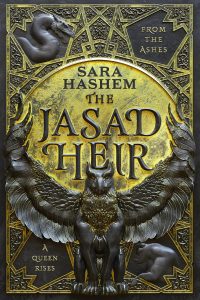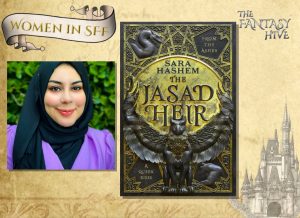Interview with Sara Hashem (THE JASAD HEIR)
Sara Hashem is an American-Egyptian writer from Southern California, where she spent many sunny days holed up indoors with a book. Sara’s love for fantasy and magical realms emerged during the two years her family lived in Egypt. When she isn’t busy naming stray cats in her neighborhood after her favorite authors, Sara can be found buried under coffee-ringed notebooks.
Link to Events, Signed Copies, & Pre-order Campaign Incentives
Welcome to the Hive, Sara! Congratulations on your upcoming debut release, The Jasad Heir! How does it feel to know that in just a few days your book baby will be out there in the wild?
Thank you so much! Gosh, my stomach just went into knots thinking about it. I started working on The Jasad Heir over three years ago. The fact that it’s finally going to be out in the world blows my mind.
To kick things off, can you tell us a little bit about it? What can our readers expect?
The Jasad Heir follows Sylvia, the fugitive queen of a scorched kingdom, who will do anything to ensure her own freedom–even if it means striking a traitor’s bargain with an enemy Heir to help him lure her own people into his trap.
Readers can expect a brutal and slightly feral main character navigating a complex world where magic, politics, and myth constantly collide.
Give us further insight into your characters, Sylvia and Arin? They’re both quite strong, complex figures who often clash—were there any interactions between them that you particularly enjoyed writing? Was there anything you came across that was tricky when developing their story arcs?
 Writing Arin and Sylvia’s interactions throughout the book was such a fun time. While Arin carries a strong sense of self and commitment to his own code, Sylvia will use one hand to wave hello and swing her knife at you with the other.
Writing Arin and Sylvia’s interactions throughout the book was such a fun time. While Arin carries a strong sense of self and commitment to his own code, Sylvia will use one hand to wave hello and swing her knife at you with the other.
Developing two headstrong characters who navigate the world in such different ways, who see the other so clearly but can’t turn that same assessing gaze inward…their conflicts were often my favorite part of a chapter. A scene I particularly enjoyed writing is a gigantic spoiler, but it takes place toward the end of the book and involves Sylvia’s unbreakable determination to keeping her moth-eaten cloak dry.
The trickiest part of Arin and Sylvia’s arc was ensuring the emotional transitions in their relationship felt natural and earned. I adore enemies-to-lovers, especially when the characters start off as true enemies with valid, powerful reasons to loathe one another. It makes the slow shift of the earth beneath the unwitting characters’ feet bringing them closer together all the more satisfying.
And who else can we expect to meet along the way? Do you have a favourite side character?
You can expect to meet scheming royals, chaotic Champions, beleaguered guardsmen, cranky chemists, and the friends Sylvia cares about (whether or not she’ll admit it).
Picking a favorite side character is tough. As much as I love Sefa and Marek, I think
Sultana Vaida is probably my favorite side character. She’s as crafty and calculating as Arin, but her powerful charisma prevents people from seeing how close to danger they might really be until its too late. She swings easily between whimsy and murder.
The world of The Jasad Heir is richly layered with much political strife and a history of bloodshed caused by the hand of the Nizahl armies across the four Kingdoms. Was there anything specific which initially sparked you to write about this? How important was it to you to show how history can be altered and much of the truth from all sides can be hidden?
Part of the inspiration came from a comment my father made when my family was preparing to leave Egypt the year following the events of the 2011 revolution. I had asked him if he thought people would know about what had happened here. His response, approximately translated: “They will know even the movements of the ants in Egypt.” So when I returned to the US and found out that actually, absolutely no one knew anything about what had happened, I was shaken. Not by their lack of knowledge, but by how certain my own had been.
Truth is an amorphous and critical concept in The Jasad Heir. Certain foundational truths build the backbone of these characters, whether they seek it out or suppress it, and I wanted to explore what it would be like if those foundations began to crack.
If you were transported into your own fictional world, out of the four Kingdoms of Lukub, Omal, Orban, and Jasad, which would you like to visit the most and why?
I think it would be awesome to visit Lukub, provided I didn’t do anything to cross Sultana Vaida and wind up in a Traitor’s Well. It’s a wealthy kingdom full of unique traditions and practices, as well as the best hiking spots. And unlike Omal or Orban, the Nizahl presence in Lukub is given far less leniency.
Your world also sees magic outlawed and the Jasadi who still possess powers persecuted. Was forbidden magic an element you had always planned to explore or did this develop as you began writing? Which aspects of your magic system or magical beings were inspired by Egyptian mythology?
Forbidden magic has been a critical element of the story since the start. So was the aspect of three of the four kingdoms losing their magic throughout the years. Building the history of loss and jealousy in the kingdoms that quietly boils for years before the Blood Summit was essential in helping me grasp how exactly three kingdoms could decide to turn against the very thing that had created them.
Much of the mythology and magic come from the stories I was told by family and classmates in Egypt! For instance, nisnas is another word for monkey in Arabic, which came as a shock to me (the word I knew was ‘ird’) and allowed my seventh-grade classmates to tell the hapless new student grand stories of the fearsome nisnas. My parents laughed themselves hoarse when I came home panicking about the nisnas coming to get us, but I never forgot the tales of the not-monkey.
A lot of the stories and customs I collected also varied geographically: Alexandria had one version, and the village where my dad grew up had another. (Umina’l Ghula, for example, was one story I never heard a consistent version of). I would even research the origins of these myths to argue with my teachers or the local shopowners, both of whom had strong opinions on the matter, but they would just insist the stories had been recorded incorrectly.
A lot of the magic and myth in The Jasad Heir features threads of those stories, as intertwined and twisted together in the book as they are in real life.
We see such varying opinions from authors when it comes to the time of editing their books. How have you found the editing process? Enjoyable, stressful or satisfying
Phew, this is a tricky question to answer while I’m knee-deep in my sequel, which has turned all my previous routines on their head.
For The Jasad Heir, I believe it took about five to six months to finish the first draft. I revised over the summer to prep the book for Pitch Wars, then I revised twice more during Pitch Wars over the span of two months. Once the book was acquired, I worked on developmental edits for over two months, line edits for one, and then proofreads for a few weeks.
I love revising. The bulk of my lightbulb moments happen during revisions. Once the foundation has been established and the rudimentary gears are in place, the best part of the process for me is tearing the manuscript apart, studying the pieces, and rebuilding it. The same amount of writing I do in a week of revisions would probably take me two months while drafting. Unfortunately, this sometimes means all I can think about while drafting is how much I’ll probably change while revising.
The Jasad Heir has such a beautiful cover, the fantastical creatures just make you want to dive right in! How involved in the process were you? Was there a particular aesthetic you hoped the artist would portray?
I was the perfect amount of involved, which is to say I participated in the initial brainstorming process and then mostly got to leave it in the hands of the experts and contribute my thoughts as it moved along. I sent pages of information about the world, characters, and kingdoms and anything else they needed. The details on the cover were created with such stunning care and attention, particularly the creatures.
The cover design was by Lisa Marie Pompilio and the cover art by Mike Heath/Magnus Creative; I truly could not have asked for a more beautiful cover or a more talented team. That cover is a showstopper, and its an immense joy to have it for The Jasad Heir.
Ok Sara, can you tell us a few teasers for your sequel? Where will you lead us next?
Deeper into the internal workings of the kingdoms at the highest levels! We’ll follow Sylvia coming into her own and learning how to be the steward of her own journey. Unexpected alliances, a whole lot of angst, major secrets, and deeper exploration of the thorny magic in the Scorched Throne universe.
Book 2 will also have take us into more than just Sylvia’s POV.
As this is our Women in SFF feature, who are the most significant women in SFF who have shaped and influenced your work?
So many wonderful women in SFF have helped me fall in love with this genre, it’s difficult to just name a few!
Richelle Meade, Kristin Cashore, Ilona Andrews, Sabaa Tahir, Ava Reid, Vaishnavi Patel, S.A. Chakraborty, and Tasha Suri have all had a role in fostering my love of SFF and the limitless dimensions of the genre.
Finally, what is the one thing you hope readers take away from your writing?
I hope they take away that there’s no singular perfect version of yourself out there to measure up against and come up short. The best version of you grows, changes, and rolls with the punches (and learns how to punch back).
Thank you so much for joining us for Women in SFF
The Jasad Heir is due to published by Orbit Books on 20th July.
You can pre-order a copy and find out more about Sarah’s upcoming events HERE

